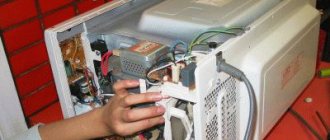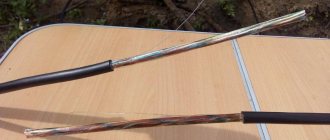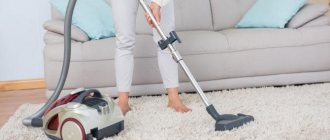A vacuum cleaner that has been working flawlessly for many years suddenly stops sucking up dust. The damage may be minor, but it needs to be found. To understand why the vacuum cleaner does not suck up dust well, what to do, and how to fix the problem, start with diagnostics. Sometimes even a superficial inspection of the device helps to find the cause. If the problem lies inside the vacuum cleaner, it will have to be completely disassembled.
Karcher vacuum cleaner does not vacuum((((
Good afternoon, dear ones.
This is the situation: a Karcher vacuum cleaner with an aqua filter has completely lost its suction power. That is, it DOES NOT SUCK dust((((((((((What’s wrong with him? How can I help him? Thank you)))) Link to description
Thank you, we did it. Everything worked)))))))
I periodically wash the fine filter in my SE3001; it’s written in the instructions, your filter is the same.
Personally, I have 2 hoses, one for wet cleaning and the other for dry cleaning, the same as yours (the problem is that I just periodically clean this place and that’s all), garbage also tends to collect on the bend of the curved solid spout, especially if you collect something large.
do not forget that at the engine output there is also a small filter that is also periodically cleaned and changed
Another piece of advice is to pull out the noise insulation filter, it will rattle a little more, but it will also add at least 20% more power.
Thanks for the advice, about all the filters I know and clean them)))) I was just VERY surprised at the garbage collection site))))) But it doesn’t have wet cleaning, there’s only an aquafilter)))
I also have a Kersh 5500 years old, 8 probably from the first I still use my original filter mainly for collecting construction waste, naturally on a household scale, just after each cleaning I wash the filter under running water at the same time I clean it with a long-haired clothes brush, then I dry it on batteries or in the summer on the balcony with a second filter I use it for regular cleaning in the apartment, I didn’t notice a big difference in the suction power, but after a year of use I threw out the hepa filter; I didn’t put a vacuum cleaner in its place; I’m very pleased with everything, it’s brilliant and the Germans are just great
Source
Diagnostics and repair of Karcher vacuum cleaners
Karcher vacuum cleaners are of high quality and have proven themselves to be the best in everyday life. However, they sometimes fail. At the same time, many vacuum cleaner breakdowns are not so serious and before contacting a service center, you can carry out diagnostics and try to fix the faults yourself. For example, diagnostics and repair of LG vacuum cleaners very often help to preserve equipment, as well as diagnostics and repair of Samsung vacuum cleaners. So why not try the same principle with Karcher products?
According to statistics from service centers that repair Karcher vacuum cleaners, the main breakdowns of the devices are:
It is not difficult to determine which of the listed problems is occurring and which spare parts to buy. It is enough to diagnose and eliminate faults.
General issues
How can I find out which accessories are compatible with the device I purchased?
Accessories compatible with your device can be found in its operating instructions or on our website. Please note: products from the Home & Garden and Professional catalogs are not compatible with each other.
Where can I test Karcher equipment?
Our dealers regularly host product demonstrations. By visiting this demonstration, you will be able to test our equipment. Demonstrations also take place at Kärcher Centers
Where can I find information materials and operating instructions?
Questions about the online store
The vacuum cleaner works, but stops sucking up dust - why is this happening?
The process of using household appliances is often accompanied by problems. Some don't require much effort to solve. If you know why the vacuum cleaner has poor suction, you can fix the problem without involving a technician. There are several reasons for the breakdown. Simple diagnostics help identify them.
The vacuum cleaner works, but does not suck up dust well and gets hot
There are few reasons why a vacuum cleaner suddenly stops working effectively. This mainly concerns clogged filters, the dust container, the hose and the pipe on which the brush is mounted. Less common are reasons related to purely technical problems, such as incorrect operation of the electric motor.
What to do if power drops
All of the above troubles necessarily lead to a drop in air suction. Accordingly, the power of the unit also decreases, that is, you can forget about cleanliness of cleaning. The vacuum cleaner works, but removes dust ineffectively.
The hostess senses this immediately and begins to get nervous. The first thing you need to do is touch the body of the device. If it gets very hot, this indicates that the motor is running under load. This should not be allowed, because the engine should not operate in this mode for a long time. It will simply burn out, which will lead to large financial costs. Or it may even lead to the failure of the entire vacuum cleaner, which will have to be replaced with a new one.
Therefore, if the housing has become hot, the unit must be turned off and not used until the cause of this situation is identified.
We repair the engine
First you need to remove the decorative protection of the case and use a multimeter to ring all sections of the circuit. Typically, equipment does not work due to a blown fuse. If this is indeed the case, replace it with a new one with exactly the same parameters. In the event that a winding break occurs on one of the coils, it is better to go and
Inventors have been trying to make carpet cleaning easier for a long time. At the beginning of the 19th century, mechanical “sweepers” appeared with rotating brushes, which were driven by the movement of the device over the carpet. In 1876, Melville Bissell patented the design of such a sweeping device (it turned out to be so successful that it is still in production). Around the same time, several other Americans offered their own solutions to this problem. In 1860, Daniel Hess patented a brush with bellows that sucked dust swept from the carpet into a special container, and Eve McGuffey created the Whirlwind (“Twister”) - a brush with a fan driven by a special lever on the handle. Both devices required superhuman effort and dexterity, so they were not widely used.
The next step was taken by Missouri inventor John Thurman, who included a gasoline engine to turn the fan in his 1898 design. It was a “vacuum cleaner in reverse” - it did not suck dust out of the carpet, but blew it out using an air stream. Therefore, the laurels of the inventor of the first “real vacuum cleaner” should be given to Hubert Booth, a British civil engineer who saw Thurman’s machine at an exhibition in London in 1901. Booth asked Thurman why he did not use dust suction instead of blowing it around, and was told that such attempts had been made, but without success. Booth nevertheless decided to try and succeeded - in the same year he created a machine called Puffing Billy (“Puffing Billy”) in honor of one of the first steam locomotives. This real vacuum cleaner did not contain any brushes and used suction generated by a pump driven by a gasoline engine. But it was too large for home use - horse traction was required to move it (when cleaning, the vacuum cleaner was parked outside, only hoses were pulled inside the building).
The first truly practical compact electric vacuum cleaner had to be invented by James Spangler, a janitor at a department store in Canton, Ohio. That's right: Spangler was asthmatic, and shaking out rugs that collected dust from visitors' shoes was a serious problem for him. Fortunately, Spangler turned out to be a very inventive person, and in 1908 he created a vacuum cleaner from a tin soap box and an electric motor with a fan and a rotating brush. A satin pillowcase served as a filter and a dust collection bag, and a mop stick served as a handle. Spangler's vacuum cleaner turned out to be very successful. One of the satisfied buyers was the wife of William Hoover, owner of a leather goods company. Hoover saw excellent prospects in this invention and offered Spangler a partnership. The first vacuum cleaner, the Hoover Model O, weighed 20 kg and cost about $60. It was much less convenient to use than a brush (and electricity was not available everywhere), but the quality of cleaning was much higher. The modern vacuum cleaner was only a short step away: in the 1930s, disposable paper dust collectors replaced fabric dust collectors, and in the late 1980s, James Dyson created a bagless vacuum cleaner based on the cyclonic filtration principle.
How to find the reason yourself
There is no need to take the vacuum cleaner to the specialist right away. There are several reasons that can easily be eliminated on your own. Let's look at them separately.
Checking the dust container and filters
The first thing to do is open the compartment where the dust collector is located.
It is necessary to explain that the vacuum cleaner is designed like a ventilation system. That is, air is sucked in on one side and thrown out on the other. There are simply several parts and assemblies installed inside the device that stop and collect the sucked dust so that the sucked air does not pass back into the room being cleaned. Hence the rather stringent requirements for dust collectors.
If it is a bag, then it is made of dense filtration material folded in several layers. That is, air along with dust gets inside the bag and passes through it, leaving dust masses inside. 100% dust does not remain inside the bag, some of it leaks out because the air pressure is quite high. So, final cleaning is carried out by special filters installed along the direction of air movement.
And since after the dust collection compartment there is a section with an electric motor, it is important to protect the latter from the smallest particles of dirt. The thing is that, although the motor has a level of protection, dust does its negative work over time. Therefore, vacuum cleaner manufacturers install several filtration barriers using high-quality filtration materials.
It is these filters that, when clogged, do not allow air flow to pass through them well. Therefore, the vacuum cleaner does not suck as expected. This means that filters need to be cleaned periodically. This is done manually using a brush. You can do it without it - by cleaning the filtration element with your hands or another object, or by tapping.
As for the bag, it is simply emptied of its contents and shaken out well. And it is again ready to collect small debris and dust, plus delay the latter from penetrating into the engine compartment.
Some manufacturers supply vacuum cleaners with paper bags rather than fabric ones. They perform the same functions, but there is no point in cleaning them. They are simply thrown into the trash, installing a new one in the compartment.
The frequency of cleaning filter bags depends on the intensity of use of the vacuum cleaner. The more we use, the more often we clean.
Plastic containers
Vacuum cleaning bags are gradually disappearing into oblivion. They have been replaced by plastic containers that operate on the principle of a cyclone. That is, inside this dust collector, when the motor is turned on, an air funnel is formed, in which all the dust collects. As soon as the electric motor turns off, it immediately falls to the bottom of the container.
A plastic container installed instead of a bag has made life easier for housewives, because garbage disposal is much easier here:
Aqua filters
And although dirty fluid has to be replaced with a new one often, this still does not affect the suction power in any way. This vacuum cleaner will work efficiently. The only thing is that you will have to look out for additional filters.
But such models of vacuum cleaners have one feature. The water filter must be filled with a certain volume of water. That is, no more and no less, which is why there is a fill level on the container. The fact is that when air moves at great speed, it also takes water dust with it. But the air inside the device performs an important function - it cools the motor. If water gets into the air mass, this will soon affect the operation of the electric motor. It’s not uncommon for the engine to simply “burn out.”
What to do
There are several steps on what to do if Karcher constantly works and does not turn off. Start with simple steps, and then move on to repairs or contacting a service center.
Try force shutdown
If your Karcher equipment does not turn off when you release the trigger, do so using the main switch. As a last resort, the voltage can be relieved by removing the plug from the socket and then looking for the problem.
Check the pressure switch contacts for sticking
A common reason why Karcher does not turn off is due to damage to the contact group. To check the version, disconnect the pump from the power source, open the tap and release the pressure to zero. After this, close the tap and turn on the equipment. Do this job at least five times.
If after completing the work the Karcher turns off normally, the problem is temporary and can be ignored. In most cases, the cause is overheating of the relay. In a situation where a shutdown does not occur at least one out of five times, the relay needs to be changed. There is no point in adjusting or repairing it.
Check the device for leaks
There are situations when a Karcher K5 or another model does not turn off and twitches during operation. An explanation for this problem may be a loss of tightness. Inspect the hose for defects and the appearance of water droplets. If there is a leak, you will have to look for a set of valves and replace them as a whole. This will save time and not have to look for specific equipment that has problems.
To replace, do the following:
- Prepare a screwdriver and use it to disassemble the housing.
- Remove the clamp that secures the engine.
- Find the valve that is located under the special nipple.
- Check its progress.
- Open all four hexagons that are on the case, discard the device, dismantle the electrical unit and separate the lower part.
- Inspect the valve tip for actual condition. If the spring is deformed, it can be straightened.
- Clean the landing area and wipe it with lubricant.
- After replacement, return everything to its place in the reverse order.
When working with valves, be careful and do not use sharp objects. The latter can damage the part and disable Karcher. In a situation where the device does not turn off, disassemble it according to the diagram discussed above and check for the presence of plaque/debris. If there is one, it is better to remove it. In the future, use only high-quality filtered water and always throw away any remaining residue after use. Also, do not leave the washer turned on during a pause in operation.
Additional Steps
Regardless of the reason why Karcher does not turn off, you can try a number of other recommendations to fix the problem. Take the following steps:
- Try replacing a microswitch that may have been damaged due to mechanical stress or normal wear and tear.
- Restore settings to factory defaults. At the same stage, try to set the optimal pressure level for the relay.
- Remove air from the Karcher system. To do this, turn on the device for a while without additional attachments.
If the above steps do not work and the device does not turn off, contact the service center. It employs specialists with the necessary equipment who carry out diagnostics, determine the cause and eliminate the problem. If Karcher is under warranty, all restoration work must be carried out free of charge.
Ways to solve problems
Having considered why vacuum cleaners have poor suction and heat, it is worth familiarizing yourself with the solution to these problems.
Everything related to the electric motor cannot be repaired on your own. This requires specialist intervention. Vacuum cleaner manufacturers are trying to improve product quality by installing high-quality components and parts. And if they fail, then more often than not they have served their time. Therefore, there is no point in repairing them. In workshops they are simply replaced with new ones.
A burnt-out motor winding can be replaced, but this still reduces the quality of the motor. Therefore, experts recommend changing it or purchasing a new vacuum cleaner. The winding burns out for four reasons:
Problems with liquids often arise. If the vacuum cleaner is not washable and does not have an aqua filter, then it cannot collect spilled liquids. Especially if there is a paper bag installed inside the vacuum cleaner. With any protection, even a small volume of water will penetrate inside the motor and reduce its service life.
Troubleshooting the board is possible, but only in a workshop. Here you have to look for an element that has burned out or stopped functioning due to the end of its service life. It is usually changed. It is rare that the entire plateau has to be removed. But this also happens.
If the voltage in the house is low, then the solution is simple - install a step-up transformer.
Product Questions
Cordless electric brooms
Is an electric broom suitable for removing pet hair?
Yes, it comes with 2 brushes – a standard one and one for animal hair. The latter allows you to easily and hygienically clean hair from any floor covering.
What to do if the battery drains quickly?
The cordless electric broom should be charged when switched off for at least 3.5 hours. If the battery does not charge even after charging for 14 hours, contact your nearest service partner.
What should I do if the brush stops rotating?
Charge the battery and clean the brush from possible contamination (for example, wound rope, etc.).
What to do if the cordless electric broom moves jerkily?
Charge the battery and clean the brush or replace it if worn.
What to do if the cordless electric broom is difficult to move?
Check the condition of the wheels, clean or replace them if necessary.
Steam cleaners / steam ironing system
Can I use a steam cleaner to clean laminate/parquet flooring?
Using a steam cleaner equipped with a steam flow regulator, you can even clean laminate or parquet (but not waxed or oiled!). With the steam supply set to minimum, treat the floor with a nozzle with two cloths (= 4 layers), reducing the direct impact of steam on the surface. Avoid prolonged exposure of the same area of the floor to steam and the formation of pools of water. If these recommendations are followed, the moisture quickly evaporates and there are no streaks left on the floor.
Useful tips
The service life of a vacuum cleaner is affected by various parameters. Of course, first of all, a lot depends on the quality of production: high-quality components and parts, as well as their assembly into a single whole. Not all manufacturers can guarantee high quality assembly, and then there are more details themselves. But even such vacuum cleaners can work for several years without creating problems.
It is important to consider the following requirements:
There is an enviable variety of vacuum cleaners on the market. There are inexpensive models, and there are premium ones. But they all have the same problem if the device is not used correctly. This is a drop in the efficiency of collecting dust and small debris, after which house cleaning cannot be called clean. Small problems can be solved independently, but there are some that require the intervention of a specialist. But, if you strictly follow the operating instructions from the manufacturer, you can guarantee that the device will work for a long time and without problems.
Why did the vacuum cleaner turn off during operation and stop turning on?
Reasons for the strong heating of the vacuum cleaner during operation
How a vacuum cleaner works and what you can do with it
Industrial vacuum cleaners for cleaning industrial premises
How to choose a manual vacuum cleaner for home use
How to choose a car vacuum cleaner based on suction power
Source
Learn more about asynchronous motors
An induction motor consists of two large components. This is a stator, a stationary part embedded in the housing, and a movable part, a rotor mounted on an axis and rotating inside the stator.
Electric motor stator: its task is to create a magnetic field
Only the stator needs a power supply - that’s what’s good about an asynchronous motor. And the rotor is a metal configuration that consists entirely of “metal frames.”
The first experiments with the rotation of a frame with current in a magnetic field: from them all types of electric motors were obtained
It was precisely from these frameworks that it all began. The first engine inventors experimented with them. Only now all the frames (and there are many of them in the rotor) are closed in the form of circuits, and no current is supplied to them or removed from them. In the generator, current flowed from the frames to the load and did something. And here in the framework, the current also appears from rotation in the magnetic field of the stator, but is immediately consumed. It follows the circuit - the field generates it, and the circuit short-circuits it. Well, and, accordingly, a magnetic field of the rotor is generated. And the result of the interaction of the fields will be the rotation of the rotor. And part of the energy of the frame-contours goes to heating.
Warming up of asynchronous motors is a parasitic property, which they are trying to get rid of. The squirrel cage gets very hot, there is a short circuit in it, and the greater the current, the greater the heating.
Squirrel-cage rotors of asynchronous motors
Measures to combat overheating are as follows:
- Make the circuit conductors as thick as possible (to increase conductivity)
- Make the entire structure as heat-dissipating as possible. It is given a shape with protrusions, ribs, the most heat-conducting metal (copper, aluminum) is taken, placed on the same impeller for forced air flow... and the result is something that looks like a squirrel cage, the rotor is called that in asynchronous motors - a squirrel cage .
Once upon a time, a current-carrying wire frame rotated 180 degrees in the magnetic field of permanent magnets installed in the stator. And so that it could continue to rotate, the direction of the current in it was changed to the opposite. Then the magnet with its two poles again pushed this frame, because its magnetic field again became a permanent magnet “against the grain.”
In an asynchronous motor, current is not supplied to the frame - it is generated in it and consumed in it. But the stator contains electromagnets, which are simply supplied with three-phase voltage, which creates the effect of rotating the electromagnetic field along the stator coils. And this rotating field, in turn, induces an electric current in the closed framework of the “squirrel cage”, that is, the rotor. Well, if current appears within the frames, they begin to rotate the rotor with their joint efforts. And the rotor “runs after” the running field of the stator faster and faster, but never catches up.
The thing is that if the rotor catches up with the traveling wave of the magnetic field of the coils, then the change in the field within the framework will become zero. This means that the reason for the frames (that is, the rotor - the squirrel cage) to rotate further will become zero. They have no induced tension, and there is no force that forces them to move. Therefore, at this moment it will simply continue to rotate by inertia until it slows down enough that electromotive force appears in it again. This phenomenon is called slippage. The rotor lags behind the rotation of the field until the increasingly increasing emf from this lag again balances the resistance to movement. And gradually the asynchronous motor itself sets the rotation speed of its rotor, which depends on the force of rotational resistance.
The resistance force at idle is the friction force in the axles during full acceleration. With good bearings, it is small enough, and the rotor will rotate “almost” synchronously with the rotation of the field in the stator coils. But when the motor does some work, a load is applied to the axle, trying to stop the rotation. For example, a fan motor rotates a fan impeller, which circulates air. This resistance exerted by the air stream will be the load.
The same applies to a pump or pump.
If a vacuum cleaner with a Karcher aqua filter is malfunctioning
If a vacuum cleaner with a Kärcher DS aqua filter has problems, should it be taken to a service center or can you try to fix the problem yourself? We have summarized all the problems that vacuum cleaner owners come to us with and identified the main ones.
Why does the suction power of a vacuum cleaner with a short service life decrease?
There may be several reasons:
If the above measures do not lead to an increase in suction power, this is a reason to contact a service center.
Releasing the power button causes the vacuum cleaner to spontaneously stop working. How can I fix this?
Most likely, the switch is faulty, but only a specialist can accurately determine the problem, so it is better to contact the service center directly.
How often do filters need to be changed?
For normal operation of the vacuum cleaner, it is enough to change the filters once a year. Premature replacement is necessary if the filter capacity is impaired or damaged, as well as if the vacuum cleaner is used intensively.
It is better to entrust the repair of household appliances to specialists. Competent consultants and experienced craftsmen of the Karcher service center will help extend the life of your household appliances, and they will delight you with their impeccable work for a long time.
Any information about goods, services, promotions, etc. posted on this website is not a public offer and cannot serve as a basis for concluding an agreement with an indefinite number of persons (Clause 2 of Article 437 of the Civil Code of the Russian Federation)
Source
Carrying out technical examination for decommissioning of computer equipment.
Model range of the best Thomas vacuum cleaners
To write off computer equipment from the balance sheet of an organization and its subsequent disposal, a budgetary institution requires a technical conclusion issued by an organization that is not interested in making decisions on write-off, and has the right to assess the technical condition of the equipment, confirming the unsuitability of the equipment for further use and its inappropriateness restoration repairs due to physical and (or) moral wear and tear. A conclusion on the technical condition of movable property, necessary for decommissioning of equipment, is issued based on the results of a technical examination. Carrying out a technical examination for decommissioning computer equipment and drawing up a report on the technical condition of the equipment are carried out in accordance with established requirements.
Atk technical condition of the monitor
ATK technical condition of the laptop
ATK technical condition of the computer
ATK technical condition of the cartridge
An act on the unsuitability of property for further use is drawn up in accordance with the established requirements for each piece of equipment, in accordance with the procedure for writing off fixed assets from the balance sheet of budgetary organizations in 2022, defined in the Regulations on the destruction of movable property, non-residential buildings, structures, structures in state ownership St. -Petersburg
Search for reasons
Diagnostics always helps to determine the cause of poor dust absorption. The procedure can be performed by anyone who knows how to use a screwdriver. However, it may not come to disassembling the vacuum cleaner if the breakdown does not affect the electrical part of the unit.
Often, a superficial diagnosis allows us to identify the following causes of poor absorption:
If these causes are not identified during diagnosis, the problem lies inside the vacuum cleaner. The weakening of the suction force occurs due to a decrease in the power of the electric motor. The reason may be brush wear, contamination of the armature commutator, loose bearings, or the formation of thick dust deposits on the fan impeller. A loss of power sometimes occurs when an electronic unit fails. As a result, the control wheel cannot change the engine speed or it begins to “float”.
To carry out superficial diagnostics, all components are disconnected from the vacuum cleaner. The inspection begins with the working nozzle, then moves on to the telescopic handle and corrugated hose. The components must be free of cracks, holes and other defects. It is important to check the inside for any stuck objects.
The dust collector and filter on the exhaust of the vacuum cleaner are further checked. These two components greatly influence the suction power. The disposable filter is replaced with a new one, and the reusable fabric bag is washed well.
Cyclone vacuum cleaners have an additional foam filter between the motor and the garbage container. The plate becomes heavily clogged with dust and needs to be washed. There is another filter on the exhaust. If it is clogged with dust, the exhaust air becomes obstructed and returns to the fan, reducing the suction power.
Ways to solve problems
Diagnostics only helps to find the cause of the vacuum cleaner malfunction. Further actions are aimed at eliminating the breakdown.
Dust collector
Overfilling the dust container with debris is the most common problem of poor suction. For any vacuum cleaner, the bag or container should not be filled more than 80%. As the clogging increases, the draft weakens or disappears completely.
Manufacturers equip expensive models with light indicators for when the dust collector is full. The green light indicates normal operation. When the indicator glows red, the dust bin is full and requires emptying. Cheap vacuum cleaners do not have this function. The dust collector has to be checked after each cleaning.
Fixing the problem of a dirty dust bin is easy. With a cyclone, you simply need to throw the garbage out of the container. A disposable paper bag is only thrown away and a new one is put in its place. The dust collector cannot be used a second time. After use and thorough shaking, the paper walls of the bag weaken. A re-installed disposable dust collector will be torn apart by a strong air flow, and dust will be drawn into the fan.
Housewives always just empty reusable fabric dust collectors. The cleaning method is good, but not effective. A large amount of dust remains between the fibers of the fabric, blocking the free passage of air. After using fabric bags several times, rinse them in clean water.
The dust collector may not be at fault if the power regulator is tightly screwed on. Sometimes turning the wheel can solve the problem of poor suction.
Fine filters
Dirty dust collectors receive more attention than fine filters, but in vain. One of them stands in front of the fan. In cyclones, the filter is usually a foam plate enclosed inside a plastic collapsible housing. The foam rubber becomes heavily clogged with dust after each cleaning. The plate is thoroughly knocked out and rinsed in water. Additionally, the plastic filter housing on the back has a fine-mesh mesh. It definitely needs to be washed.
The second fine filter is located on the exhaust of the vacuum cleaner. Usually it is made in the form of a separate box with many cells. The filter prevents dust residues from flying out of the vacuum cleaner into the room. Clogged cells are cleaned with a soft brush or rinsed with clean water. Similar procedures will be successful a couple of times. After 50 hours of operation, the filter must be replaced.
Accessories
The components of the vacuum cleaner include a corrugated hose, a telescopic handle, and working attachments. During cleaning, a large object accidentally pulled in gets jammed at bends or transitions. You can clean the hose and telescopic handle with a long stick without burrs or soft insulated wire. The air channel of the working nozzle is usually curved. It is easier to clean it with something that bends well: wire, cable, elastic PVC rod.
After cleaning, check the wheels on the brush. Hair often gets wrapped around them. If the roller is equipped with bearings, lubricate them.
Additionally, the connection points of all elements are checked. Loose locks, cracks and other defects create air leaks. A broken hose is immediately replaced. The gap is temporarily repaired with an adapter sleeve. The hose is cut, a piece of plastic tube is inserted inside, the joints are clamped with clamps and wrapped with tape.











